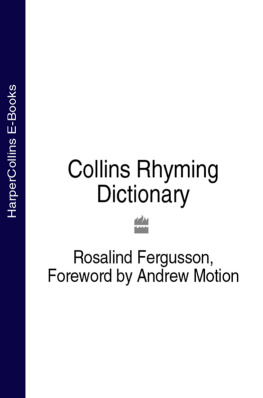SHAKING HANDS
Rhyme is a connection between the sounds of syllables, not words. Only the last syllables rhyme in
under wear
re pair
The other syllables,
under
re
do not figure in at all.
When two syllables rhyme, it means three things:
- 1.The syllables vowel sounds are the same
w ea r
p ai r
Even though these syllables vowels have different letters, they make the same sound in these words. Only your ears count, not your eyes.
- 2.The sounds after the vowels (if any) are the same,
ea r
ai r
(As you can see by the ea in wear and ear, sometimes the same letters sound different in different contexts.)
(If any) is important because syllables dont always have consonants after their vowel sounds, as in
disa gree
refe ree .
- 3.The sounds before the vowels are different.
w ear
p air
This third characteristic is important. It shows that rhyme works by the basic musical principle of tension /resolution: difference moving into sameness. When you hear a rhyme,
your ear notices that, in spite of the difference at the beginnings of the syllables, they end up sounding alike!
Beginnings of rhymed syllables have to be different so your ear will notice the similar sounds at the end. Otherwise, your ear will pick up only repetition, not rhyme. When you hear a cheerleader yell
go! go! go! go! go!
you pay attention to the repetition, not to the sounds of the syllables. No one in the stadium thinks Hey! Those syllables sound the same!
When the beginnings of syllables are the same, the syllables cannot rhyme. This is called an IDENTITY:
fuse
con fuse
It is not a rhyme. Your ear does not pay attention to the sounds of the syllables. There is no tension, no difference to be resolved by sameness.
These words do not call attention to their sounds either, because their syllables do not resolve difference into sameness. The same sounds are repeated, just like a cheerleaders yell. But try
These are a big difference from the Identities above them. There is also a big difference between these two lists:
- birth place , common place , mis place , place, re place
- ace, brace, chase, erase, face, disgrace, resting place
Say them aloud. Your ear does not focus on the sounds in the first list, but is drawn like a magnet to the sounds in the second list. In the first list you hear simple repetition. In the second list you hear the sound of music or, rather, of tension /resolution.
Look at the three conditions again.
- The syllables vowel sounds are the same
- The sounds after the vowels (if any) are the same,
- The sounds before the vowels are different.
When syllables meet all three of these conditions, call it PERFECT RHYME. Later I will show you other kinds of rhyme besides PERFECT RHYME.
MASCULINE RHYMES/FEMININE RHYMES
Most rhymes, including PERFECT RHYMES, belong to one of two categories. Never to both. Every rhyme is either MASCULINE or FEMININE. (We will conveniently ignore three-syllable rhymes, at least for now.)
Here are some MASCULINE RHYMES:
command
land
understand
expand
strand
Here are some FEMININE RHYMES:
commanding
landing
understanding
expanding
stranding
As you can see, the difference is in the way they end.
MASCULINE RHYMES are either one-syllable words, or words that end on a stressed syllable:
FEMININE RHYMES always end on an unstressed syllable. They are always two-syllable rhymes. (Masculine rhymes are one-syllable rhymes.)
Look at the stressed syllables in the FEMININE RHYMES above and you will see that they are all PERFECT RHYMES:
Stressed syllables, whether in FEMININE RHYMES or MASCULINE RHYMES, create rhymes tension and resolution.
The unstressed ending syllables above are all IDENTITIES, which is normal for Feminine Rhyme. These IDENTITIES only continue the resolution. Unstressed syllables of FEMININE RHYMES are usually IDENTITIES, but they do not have to be.
Call these pairs above MOSAIC RHYMES, since they are put together with syllables of different words, like stained glass pieces in a church window.
Some words end on secondary stress, a syllable that, while it is not the primary stress in the word, is stronger than the syllables around it. Use // to mark secondary stress.
Listen to it. You can tell by the pitch of the last syllable that it is stronger than the syllable before it. You cannot treat it as Feminine Rhyme, since its second-last syllable is the unstressed syllable. All Feminine Rhymes have a stressed second-last syllable, or at least their second-last syllable is stronger than the last syllable.
You have two choices when you rhyme appreciate:
- 1.You can treat it as a one-syllable Masculine Rhyme.
appreciate
fate
relate
Even better, you can rhyme it with other secondary stresses:
These three-syllable rhymes are still Masculine, since their last syllable is more stressed than the one before it. The somersaults you have to turn for these little gems are worth it only if you are writing comedy. They sure do dance.
FINDING RHYMES
Occasionally when Ive asked writers what rhyming dictionary they use, some have been indignant, as though to say, I do not cheat. I am self-sufficient. Others have looked at me sadly, as if hoping that someday I will abandon my artificial crutch and get in touch with my creative inner self.



















